Are you thinking of climbing Margherita Peak or trekking the Rwenzori Mountains? Then read this first!
Welcome to Diary of a Muzungu! This week’s guest post is by Jane Goldring, with photos for this story kindly provided by her husband and brilliant photographer Paul.
If you’re planning to climb Margherita, or just interested in hiking or mountain climbing in Uganda, look no further. Below Jane’s story, you’ll find a Rwenzori trekking packing list and some travel advice on how to plan your Rwenzori hike, as well as links to other East African mountain climbing stories (notably How to Climb Mount Kilimanjaro – tales of a novice climber and A girl called Kevin: Climbing Mount Elgon, Uganda).
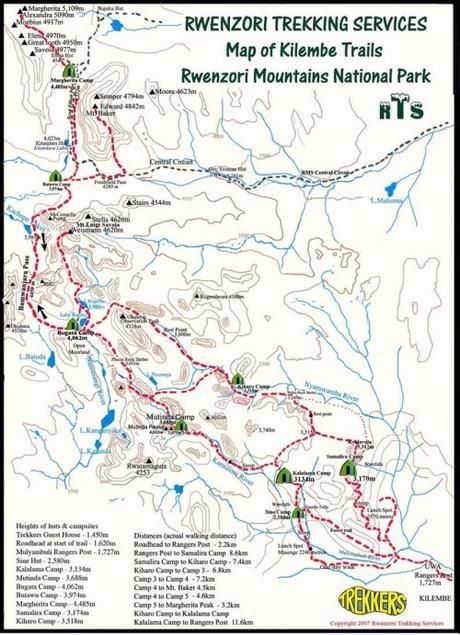
Rwenzori Trekking Services Kilembe Trails map Uganda
Jane writes:
Rwenzori trekking – Day one
After an early start and a traditional Western breakfast, we left Kasese for the start of our Rwenzori trek, a 30 minute drive out of town past the Margherita Hotel towards Kasese Cobalt mine. We had been warned we could not get right the way up to the Rwenzori Trekking Services office due to a flood and rock slide which had taken out the bridge and last part of the road. Finding our guides Moses and Richard en route, we had help hauling our luggage up the hill to the RTS offices, where it was time for the formalities: sharing details of medical issues, insurance, food allergies and emergency contacts. It was here that we signed up the sixteen porters needed to carry our luggage, equipment, fuel, food and other supplies our group would need to trek the Rwenzori Mountains.

Rwenzori trekking: the adventure started even before Jane had entered the National Park – the road from Kasese had been swept away…. How to hike Margherita Peak
And so at 9:45am we started trekking up the road past the dilapidated mine housing estate which was buzzing with life: ducks in the muddy gulleys, chickens, goats and even a pig or two, as well as people going about their daily life in the little duuka shops, bars and houses with long lines of clothes washing.
At the entrance of the Rwenzori Mountains National Park, trekking formalities concluded with payment of park entry fees ($40/day).
Now in the Park, we started up the path in a single file through forested slopes and arrived at the first stopover, Sine Hut, at about 4:00pm. At 2596 metres, Sine Hut is situated on top of a long ridge amongst pine and other trees. Steep slopes on either side of the ridge lead down into deep valleys and amply flowing rivers. Similar to a traditional Alpine wooden hut, Sine Hut has a terrace and four sets of bunk beds. A flask of hot water for tea and bowl of fresh water for washing awaited us, after which our short exploration of the area revealed a valley river and a small waterfall of icy water.
Back at Sine Hut, it was time for our first dinner up the mountain. Our three course meal of soup, main and dessert was very tasty, with huge quantities of carbohydrates that we struggled to finish. A couple of rounds of cards and soon we were feeling rather tired and so, not long after dark, we all retired to bed as mist started to roll in with the cool air.
Rwenzori trekking – Day two
Day two’s trekking started at 8:30am (after a hearty breakfast of cereal, omelette, toast and bacon too!) through a forested area, with glimpses of more Rwenzori foothills through the gaps in the trees ahead. We were lucky to see L’Hoests monkeys and heard the calls of Rwenzori Turacos – but did not see any yet. Due to the last few months’ excessive rains, we also saw areas of landslides where the ground seemed to still be sliding down the mountainside. As the mist rolled in, we saw no more. We walked along the path on the mountain’s edge; while we figured there was a steep drop, we could not see anything. The path became rockier and, as we scrambled over rocks, we focused our energy and vision on each step in front of us.
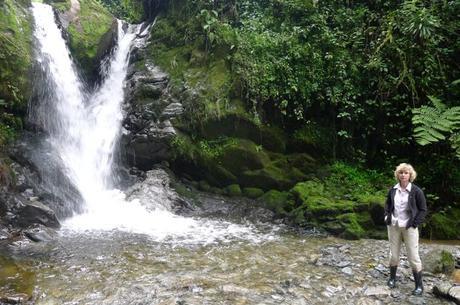
Waterfalls. Rwenzori trekking: how to hike Margherita.
Our lunchtime sandwiches next to a fast flowing river were interrupted when the heavens suddenly opened. We changed into our gum boots (or Wellington boots as the British call them) and rain gear and set off again almost immediately – trying to beat the weather. After some time I realized that I was feeling very cold and wet. Guess what? The freezing cold rain – we were now over 2000 metres high – was going directly through that wonderful North Face jacket from Kathmandu. Luckily my porter was nearby and I had a spare rainjacket (a cheapie ‘security guard style one’ from Entebbe Supermarket). The spare rainjacket and dry sweater saved the day, even if I didn’t look as fashionable as the rest of the party in their good quality rainjackets.
Shrouded in mist and wet from the recent rain, the Alpine zone plants were a little unreal; the wonderland of large overpowering plants and trees draped in white “Old Man’s Beard” (Usnea) gave me the feeling of being in a movie set.
Our next camp – Mutima Cave – was at an altitude of 3688 metres. Here a couple of tents were placed under a rocky overhang forming a rather makeshift, but very welcoming, overnight stop. We enjoyed an evening keeping warm around the fire and chatting with two very energetic and fit Dutch ladies who proudly told us they had just managed to summit Margherita Peak. They had lost a day due to bad weather and so had just completed two days of Rwenzori trekking in just one day – 10 hours of fast hiking – so that they could keep to their tight schedules. A little daunting for us not quite so fit ones.
Rwenzori trekking – Day three
Being now seasoned mountaineers, after two days on the go, we were up and ready in no time at all with our gum boots on (and taped to our waterproof trousers, just to be sure), sun gear, enough layers of clothing to put on / take off as the need arose, our snacks ready at hand and lots of drinking water.
The day begun a little cool and dull, but with no rain to begin with, which we were pleased about as this was our first real day of hiking through the bogs. Negotiating the boggy ground requires you watch every step to ensure the ground really is solid, or at least only a shallow bit of mud, as you zig zag upwards as a cross. A long walking pole proved to be well worthwhile here.
By 11:00 am the skies had opened again and we trudged along in the rain for a good part of the day with visibility not much more than a few metres at a time. In the afternoon, the weather improved and the sun came out and we suddenly saw the wonderful views of the Rwenzori Mountains – range after range of them. It also became very noticeable how the whole area we had been walking through had been badly damaged during the fire of February 2012.

Fire damaged vegetation is starting to regrow. Rwenzori trekking: how to hike Margherita.
Burnt stumps of trees or bushes were everywhere; fortunately, new small plants and shoots were appearing but I have been told it may take up to 20 years for these areas to fully recover since many plants grow at quite a slow rate at this high attitude.
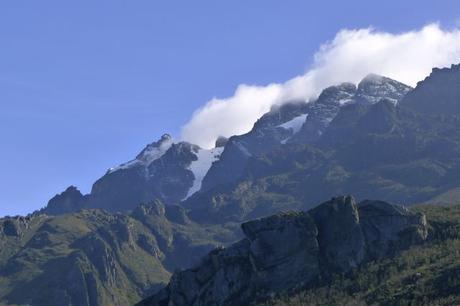
Glimpse of the peaks. Rwenzori trekking: how to hike Margherita Peak
By 11:00 am we had reached the high point of 4400 metres and were at the top of the pass where you have views towards Mount Stanley and Baker’s. The sun was shining and, despite the altitude headache, we could not have enjoyed clearer, better views. This is what we had come to see – wonderful indeed!
Next, we began the descent to another river valley; you might think that going down would be easier but not in the Rwenzoris – still you need to balance and check where to step (plus endure the continual impact on your knees as you land your weight on each one). Seeing a Scarlet-tufted Malachite Sunbird enjoy the weather was a highlight of our two 2 hour hike to the bottom of the hill. After lunch we set off again “just around the corner” of a lake, as our guide Richard called it. We continued around the tranquil-looking lake on what appeared to be a used route (but not what you would call a path as there were huge boulders higher than me) as well as clips, hills and weaving areas of mud that we had to make our way through.
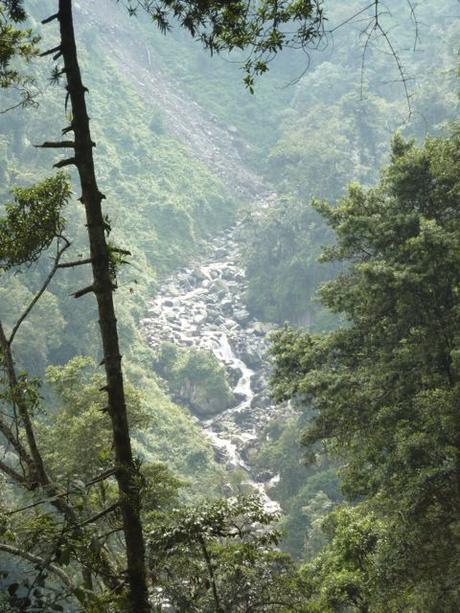
Decsent to a river valley – not as easy as it looks! Rwenzori trekking: how to hike Margherita
By this stage our fit and fast hiker Helen was way ahead with Moses, one of our guides. Next there were me and Andrew with Paul bringing up the rear, all coping in our various personal ways with the hiking conditions.
Our guide Richard was doing a wonderful job, showing me the best routes and where to step. At other times he hung back to help ensure Andrew and Paul were coping well too. By around 4:00 pm we were “around the corner” (which you may have gathered was not quite the usual corner we imagine but rather longer indeed) and in a valley. Here we could see the next section of our hike towards our next camp: Hunwick’s Camp at 3974 metres, which of course was over the next hill and into the next valley… We started through the bog again – tussock-hopping and choosing as many ‘low mud impact footholds’ as we could and then up the hill……quite a tough one for the end of a long day like this. We eventually rocked into Hunwick’s Camp at around 6.00 pm totally exhausted and feeling like we have reached the end of our energy levels. Thank goodness the weather had held and we were able to see the wonderful views of Mount Baker with its snow and glacier blinking in the late afternoon sun.
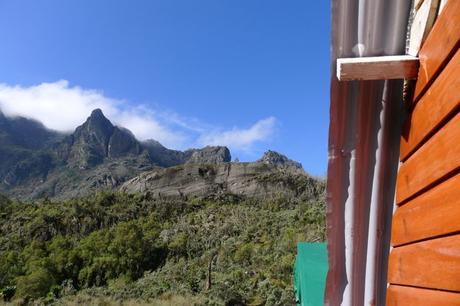
View from Hunwick’s Camp. Rwenzori trekking: how to hike Margherita Peak
The headache was there again and some swelling of our face and ankles were starting to be apparent (first signs that our bodies were not doing well in the altitude). Andrew’s feet were killing him as he was wearing gum boots with such thin soles he felt he could “tell if a coin placed underneath his boot was head or tails.”
That night was cold. Despite two sleeping bags, two layers of clothes, my hat and a fleece over the top of that, the wind whistled around our camp and seemed to find cracks to blow directly into my back. Getting up for the inevitable night time pee was not fun and I came back to bed exhausted from the effort, feeling quite short of breath at times. It was at this point that I began to wonder what I was doing all this for.
Rwenzori trekking – Day four – and a day off
The next morning my small mirror revealed a new face – one that was so puffy and swollen that my eyes were just small slanty slits, the effect of not coping well with the altitude, I was told. I therefore decided I would not go on further to Margherita Peak but rather have a rest day and then return downwards (which actually involved going back up to 4400 metres before the real descent). Andrew and Paul followed suit while we waved Helen off as she decided to push onto the Peak.
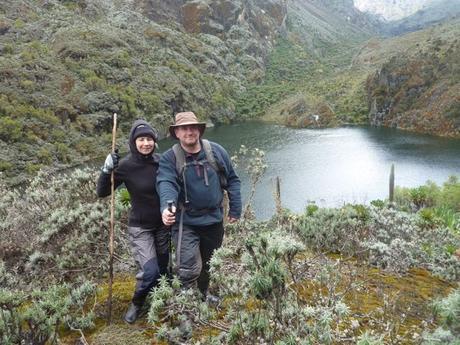
A day’s rest at Lake Kitandara. Rwenzori trekking: how to hike Margherita
We spent the day relaxing and enjoying sunshine, taking a stroll down into the nearby valley near the twin lake of Kitandara. It felt wonderful to walk without time pressure and to stop and enjoy the scenery.
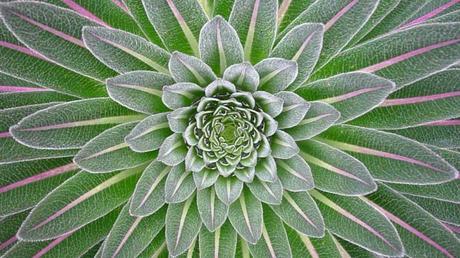
A botanist’s dream: the Rwenzori plants are out of this world – huge and strikingly beautiful.
We stopped at Lake Kitandara Hut, where we met a geology student with her team. She explained that Mount Baker has risen at least 3 mm each year for the last few years, possibly due to extreme heat and pressure in the base of the Rwenzori Mountain range in the earth’s crust. The mountain is actually moving slowly northwards too.
We basked in the late afternoon sunlight until it disappeared behind the tops of the mountains – and evening arrived quite suddenly.
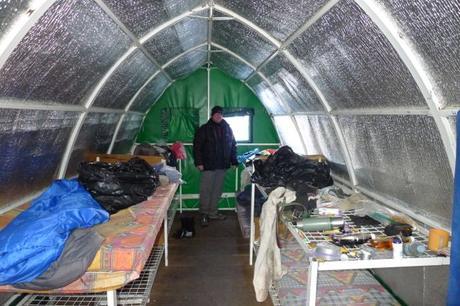
Space age insulated accommodation! Rwenzori trekking: how to hike Margherita
The accommodations were very comfortable, especially considering where we were. We slept in two rounded, framed huts with waterproof outer covers and insulated walls. Each hut has four sets of bunk beds. Meals and copious cups of tea are taken at the tables and benches in the separate dining tent.
Rwenzori trekking – Day six
After a rather restless night worrying about going back up the mountain to go down, we woke early. After our usual heavy breakfast, we hiked back down into the valley “Around the Corner” and back along the lakeside before taking a short break and then heading up the river valley again. It was tough going and quite warm too. The stream provided wonderful clean water to help quench our thirst and, closer to the top, we looked backward for a full view of so many mountains: Mount Stanley and numerous peaks, including Alexandra, Elena and Mount Speke, Mount Baker, Weisman and other peaks we tried to identify thanks to the lovely, clear blue skies.
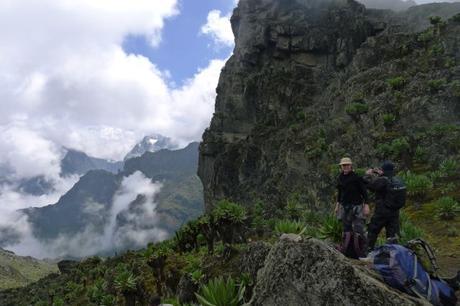
Watching the world go by… Rwenzori trekking: how to hike Margherita
Over the top of the Banwanjara Pass, we sat for some time watching the clouds move up and around Mount Stanley tantalizing us as we kept hoping to see Margherita Peak. As clouds cleared, we watched; at the last moment the clouds would change their minds and U-turn to block out that section again and again. The sun was lovely and warm and the striking views all around us were perfect; just what we felt we deserved after all the tough hiking.
However it was not over yet for the day and reluctantly we moved down through the areas of open rock, bogs and riverbeds full of boulders, previously climbed in misty, wet conditions. Evidence of the fire of 2012 was quite prevalent in this area and, looking back towards Kasese, we could see range after range of Rwenzori Mountains, making us realize the large distance we had covered over the last few days.
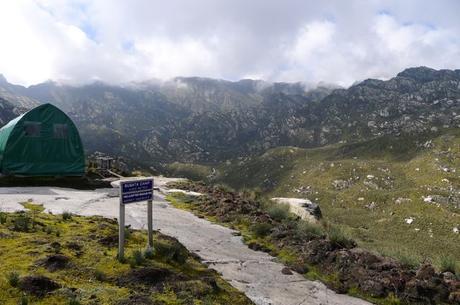
Bugata Camp. Rwenzori trekking: how to hike Margherita
Arriving at Bugata Camp was like returning home: warm showers and hot cups of tea were ready for us. This time we had the pleasure of swapping mountain stories and sharing the camp with visitors who had just completed Margherita Peak.
Rwenzori trekking – Day seven
From this point, we had to decide which final route we would take down the mountain: the different (harder) route or the same (easier) route by which we came up. We opted for the easier route in the end (I think our guides and porters were quite pleased with our choice too).
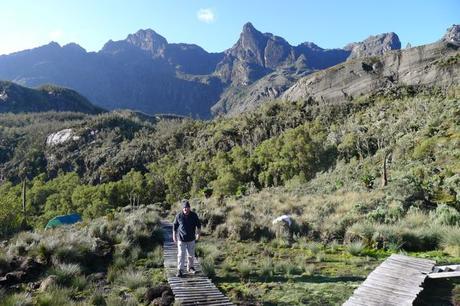
Board walks help trekkers cross bogs and swamps. Rwenzori trekking: how to hike Margherita
The route that had taken us over 7 hours up, now only took us around 5 hours down, even with stopping to photograph many of the plants and scenery we had missed due to the bad weather on the upward journey.
We were back at Mutima Cave by mid-afternoon, where it was time to reorganize our luggage, dry out our socks by the fire and munch our way though some of our leftover snacks – suddenly with the lower altitude we were feeling peckish. After dinner we sat around the fire recounting stories and sipping our little flask of Whiskey or Amarula that we now felt it was safe to consume (apparently alcohol is not good for you at altitude) until we finally retired to bed, feeling rather relaxed and more comfortable at this lower altitude.
Rwenzori trekking – Day eight
A relaxed start of the day, heading for Kalalana Camp at 3134 metres which we had passed on our route. Here the beautiful Giant Lobelia stand almost two metres high with their long stems, purple flowers and leaves that hold the rainwater like a basin. Next we entered the Heather Zone. This same low-lying bushy plant (typical of the British countryside) grows into trees of over 15 metres high; often their branches are covered in the white Old Man’s Beard. Presumably we had become more hardy and a bit fitter; whilst the route was still quite rocky or boggy at times, we found the route quite pleasant and enjoyable. Through the day we had clear views back towards Kasese Town, making us realize how far we had hiked and why we felt quite tired from the exertion of the last week.
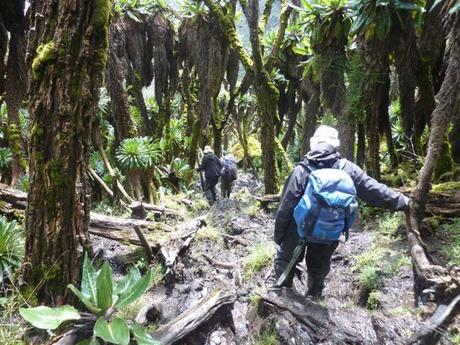
The vegetation is larger than life! Giant Lobelia. Rwenzori trekking: how to hike Margherita
By around 3:00 pm we were in camp where we relaxed in the afternoon sunshine, feeling so much more energetic now that we were down to just 3100 metres. We sat down to hear Helen tell us about her journey to the Peak: Margherita. She had enjoyed a cloud- and wind-free morning – perfect conditions for a summit day.
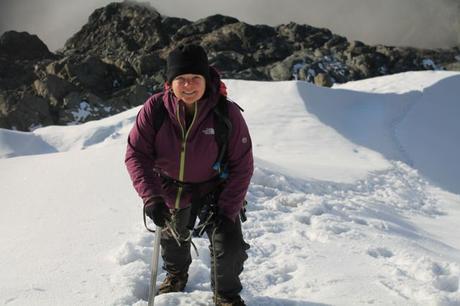
Not everyone manages to summit Margherita Peak – but Helen did. Rwenzori trekking: snow on the Equator!
We heard how tough it was hiking in crampons up the two glaciers and how she’d had to step over deep, dodgy-looking crevices in the ice. Helen had succeeded in reaching the Peak at 5109 metres above sea level – quite an achievement for sure.
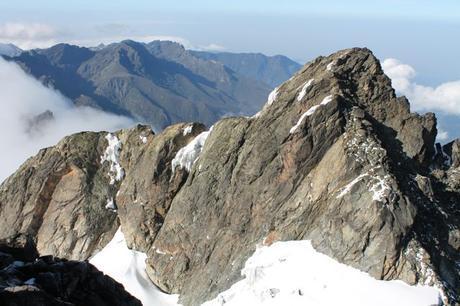
Margherita Peak is 5109 metres above sea level
Our last evening up the mountain, we celebrated with the last few snacks and a good dinner of fresh roasted chicken (that had miraculously arrived up the mountain from a resupply from Kasese), the last of our “bar” and swapped anecdotes from the journey of the last eight days. By 10:00 pm we were all fast asleep, even with the wind howling and the rain battering our hut roof.
Rwenzori trekking – Day nine
The last day arrived with gloomy skies threatening rain but nothing could scare us now, so off we set again downwards, through the bamboo zone, slipping and sliding down the slopes and into the afro Alpine mountain forest zone. We wound our way down very steep paths that I could not quite believe I had managed to climb only a week earlier. The path seemed to go on forever and it was only around 2:00 pm that we made it to a recognizable point. At the park entry gate, the same clerk who had signed us in to Rwenzori Mountains National Park now asked us to sign out.
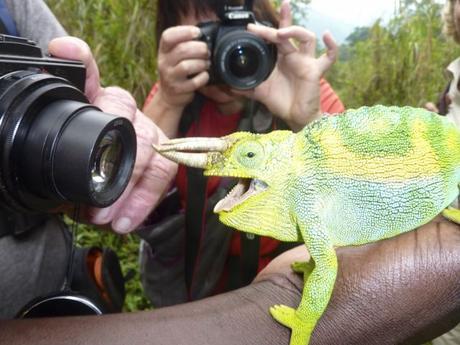
Three-horned Chameleon putting on a show for the cameras. Rwenzori trekking Ruwenzori Mountains, Uganda
The final hour Rwenzori trekking was through hillside villages and finally onto the road via the Kasese Cobalt Mine village and the Rwenzori Trekking Services office and home base where we were warmly welcomed back – and offered an ice cold beer – just the ticket indeed! After a few photos and a small award ceremony with our guides and porters who had been so patient and helpful the whole journey, we headed to Ndali Lodge for a couple of nights of rest and relaxation after this epic journey.
What a sense of achievement we all felt having made it up the mountain and back and experiencing everything it had to offer – both positive and negative – sunshine, rain, cold, mud, wonderful views, plants, birds, beauty, balancing challenges and much more.
ABOUT THE WRITER: Jane and her husband Paul Goldring are co-owners of destination management company G&C Tours Ltd, owners of Wild Frontiers Uganda, one of Uganda’s leading tour operators. Their “who’s who” of famous celebrity, TV and film maker clients choose to stay at Exclusive Camps Uganda’s fabulous Ishasha Wilderness Camp in Queen Elizabeth National Park, the sensational Buhoma Lodge in Bwindi Impenetrable Forest and – the latest addition – Baker’s Lodge in Murchison Falls National Park. The company’s unique Platinum Mobile camping services (incorporating chartered fly / drive options) provide flexible luxury accommodation across the country.
Planning your Rwenzori trekking – what to consider before you book
Route
Remember: you don’t have to climb – or summit – Margherita Peak itself. Rwenzori Trekking Services offer a range of shorter hiking options, all with the same dramatic backdrops.
Best time of year for Rwenzori trekking
Feedback from friends suggests that January, February and March are the best months to trek as it is the driest time of the year.
I almost climbed the Rwenzori Mountains… I had just I climbed Uganda’s Mt. Elgon with volunteer friends, but my knee injury on day one of our five-day trek meant I was still out of action when my friends summited the Rwenzori’ s Margherita Peak that November. When I asked whether they had enjoyed their trip, they said NO! …. After all their planning and training? I couldn’t quite believe it! Their mistake? They had chosen to hike during the rainy season when certain sections of the trek are hellishly boggy, making progress very difficult and tiring. Time your hike right, and you will enjoy this once-in-a-lifetime experience far more.
Fitness and medical issues
Rwenzori trekking requires a good level of fitness. You will be asked about your general health when you book your trek.
Altitude sickness can be a problem for many people.
I know, I’ve had it. It’s not nice. (Think combination of seasickness and sunstroke, with a banging headache for good measure).
The best way to avoid altitude sickness is to ascend slowly. It’s highly recommended that you consider taking a day off mid-climb, as Jane did, to acclimatise to the high altitude. Even if you don’t summit, you may benefit from a day’s rest and acclimatisation. Having experienced altitude sickness myself, I will definitely take a rest day when I climb the Rwenzoris.
Insurance
If you’re planning to climb the Ruwenzori’s, particularly if you are climbing Margherita, you are advised to take out travel insurance.
Emergency contacts
You will need to provide these when you sign the disclaimer form before starting your trek.
Who to trek the Rwenzoris with
Rwenzori Trekking Services are generally acknowledged as the best operator in Uganda for trekking the Rwenzoris. They tours are inclusive of Rwenzori Mountains National Park entry fees, which are $40/day (2015 price).
Planning your Rwenzori trekking – what to pack
Hire a Porter
Porters are allowed to carry a maximum of 15 kg each. This will include your clothes, hiking and camping equipment and all your food. The porters will collect firewood and water every evening for you at camp so you only need to carry one day’s personal supply of drinking water at a time. Do not even think of climbing without the help of a porter – not only will you be able to focus on enjoying the breath-taking scenery, you’re providing valuable employment. Expect to pay $15 per porter per day. A tip of $5-10 per day will make your porter very happy indeed.
Ranger guides
Since you will be walking in the Rwenzori Mountains National Park, you will be allocated two or more armed Uganda Wildlife Authority rangers who will act as your guides throughout the trip. Expect to be Facebook friends by the end of it! These guys will also appreciate a tip.
Walking pole
Invaluable! No need to spend money on one of those fancy walking poles, just ask one of the guides to cut down a piece of bamboo for you.
Waterproof clothing
Don’t scrimp on the quality of your rain jacket. It can make or break your trip. Ensure you only buy the best quality and make sure it is tested. It’s a vital part of your kit on this mountain where it can rain for days on end.
What to carry in your day pack
Your day pack (personal rucksack) should contain your waterproof jacket and waterproof trousers, drinking water, sunscreen, mosquito repellent and snacks.
Snacks
Stock up on plenty of your favorite snacks. G’ nuts (groundnuts), biscuits, bananas and dried fruit will give you more energy than chocolate and sweets.
Water
To keep hydrated at altitude, you will need to drink at least two litres of drinking water per day, even in cold weather. The porters collect and boil water every night. By the time you drink it the next morning, it will have cooled nicely.
Footwear
Hiking boots with ankle support are the best option. Leave your trainers at home, they don’t have enough grip. If you plan to wear Wellington ‘gum’ boots, get some good insoles. My recommendation is to wear ankle-high boots with gaiters, which will keep out a lot of rain and water (and most insects).
Hot water bottle
I love Jane’s tip about the improvised water bottles! However, you could take a proper hot water bottle with you (I certainly will! I remember how bloody cold it was on Mount Elgon at night…) Remember, you will have a porter to carry everything for you.
The Muzungu: thanks Jane for sharing your great adventure! I’m seriously considering trekking the Rwenzoris now – I know how hard it was to get as far as you did, and you’ve proved to me that there is no need to push yourself to the extreme and summit. What a brilliant experience you’ve had!
If you enjoyed this story, feel free to share it 

Have you signed up for Diary of a Muzungu’s regular free newsletter yet?
Tags:
Adventure, Climbing Mount Elgon, East Africa, hiking, How to hike the Rwenzoris, Margherita Peak, Mount Elgon, Mount Rwenzori, mountain, mountain climbing, packing list, Ruwenzori trekking, Rwenzori trekking, Rwenzori Trekking Services, travel tips, Uganda Travel« An invitation to Masaka: the inaugural Uganda International Marathon! May 24th 2015

